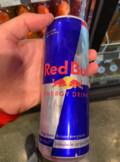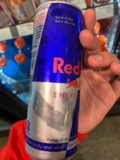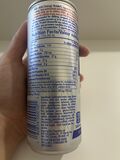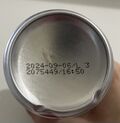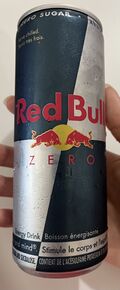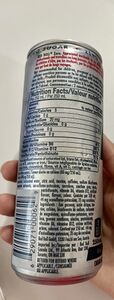Course:FNH200/Assignments/2023/Original Red Bull versus Red Bull Zero
Photos
Please click on the photo to enlarge it!
-
Fig. 1. View of Original Red Bull can's front. "Served chilled" is more clear to the viewer.
-
Fig. 2 Alternate view of Original Red Bull can's front
-
Fig. 3 Nutritional Content of Original Red Bull.
-
Fig. 4 Bottom of Original Red Bull, showing date marking.
-
Fig. 5 Front of Red Bull Zero.
-
Fig. 6 Nutritional Content of Red Bull Zero.
-
Fig. 7 Bottom of Red Bull Zero, showing date marking.
Ingredient lists (4 points)
| ORIGINAL RED BULL | RED BULL ZERO |
|---|---|
|
|
| FAT SUBSTITUTES | SUGAR SUBSTITUTES | ADDITIVES | |
|---|---|---|---|
| Original Red Bull | N/A | N/A | Citric acid
Sodium bicarbonate Magnesium Carbonate Caffeine Colour |
| Red Bull Zero | N/A | Sucralose
Acesulfame potassium |
Xanthan Gum.
Citric acid Sodium bicarbonate Magnesium Carbonate Caffeine Colour |
Role of Substitutes and Additives used
Original Red Bull
Fat Substitutes
- NONE
Sugar Substitutes
- NONE
Additives
- Citric Acid: has great flexibility in terms of flavor, preservation and stabilization. Enhances flavor by cutting unpleasant sweetness and adding a sour and refreshing component. The pH level of citric acid prevents bacteria and microorganisms from growing.[1]
- Health Properties: Yet, lemon essence, the kind of citric acid commonly used in carbonated drinks can cause tooth decay and gastrointestinal issues if consumed regularly.
- Sodium Bicarbonate: responsible for carbonation (through reacting with citric acid), used as a neutralizer to balance acidity[2]
- Caffeine: used to increase mental/physical stimulation and energy.
- Magnesium Carbonate: supplies a source of magnesium which regulates acidity and enhances sweet/sour flavors
- Health Properties: can support muscle growth and increase energy
Red Bull Zero
Fat Substitutes
- NONE
Sugar Substitutes
- Sucralose: 600 times sweeter than sucrose but non-caloric sweetener, so contributes 0 Cal/g when consumed, and non-cariogenic, meaning it does not contribute to cavity development. May be consumed by diabetics as it has no effect on blood glucose or insulin levels as it doesn’t affect carbohydrate metabolism.[3]
- Acesulfame potassium: used in conjunction with other sweeteners, in this case with sucralose, to further enhance the sweetening effect. Is 200 times sweeter than sucrose. Unable to be fermented by oral bacteria, preventing cavity development. Also a non-caloric sweetener, so contributes 0 Cal/g when consumed.[3]
Additives
- Xanthan Gum: Polysaccharide that improves mouthfeel primarily by preventing a slimy texture in liquids and can be used to enhance taste.[4]
- Citric Acid: has great flexibility in terms of flavor, preservation and stabilization. Enhances flavor by cutting unpleasant sweetness and adding a sour and refreshing component. The pH level of citric acid prevents bacteria and microorganisms from growing.[1]
- Health Properties: Yet, lemon essence, the kind of citric acid commonly used in carbonated drinks can cause tooth decay and gastrointestinal issues if consumed regularly.
- Sodium Bicarbonate: responsible for carbonation (through reacting with citric acid), used as a neutralizer to balance acidity[2]
- Caffeine: used to increase mental/physical stimulation and energy.
- Magnesium Carbonate: supplies a source of magnesium which regulates acidity and enhances sweet/sour flavors
- Health Properties: can support muscle growth and increase energy
COMPARE AND CONTRAST
Both Original Red Bull and Red Bull Zero have no fat additives and mostly have the same types of additives: citric acid, sodium bicarbonate, caffeine and magnesium carbonate. Other ingredients in common are carbonated water, vitamin B6, vitamin B12, artificial flavour and colour.
Original Red Bull does not have sugar substitutes, instead using sucrose and glucose-fructose since the drink isn’t marketed towards consumers who are conscious of their sugar intake. This results in the higher caloric content, in comparison with Red Bull Zero.
Red Bull Zero uses both sucralose and acesulfame-potassium which are both noncaloric sweeteners that are perfect for consumers who are watching their sugar intake or for diabetics who need to watch their glycemic levels. These two sugar substitutes also do not promote tooth decay, as opposed to sucrose and glucose-fructose.[3]
Red Bull Zero also contains xanthan gum. In the case of beverages, xanthan gum is a bodying agent, meaning it's used to create a cohesive, consistent mouthfeel which then improves taste.[4] This is to ensure that consumers who opt for an alternative version of a product can still experience the feel of the original product.
Labels (1 points)
- Provide detailed description of the information found on the labels
- Indicate whether the information complies with the regulatory requirements as outlined in Lesson 04.
| Original Red Bull | Red Bull Zero | |
| Common Name | Red Bull Energy Drink | Red Bull Zero |
| Bilingual Labelling | Labels are in both English and French. | Labels are in both English and French. |
| Net Quantity | 250 mL, or one can. | 250 mL, or one can. |
| Identity of Business | Red Bull | Red Bull |
| Country of Origin | Austria | Austria |
| Date Marking | Bottom of can. No storage instruction needed. | Bottom of can. No storage instruction needed. |
| List of Ingredients (in descending order of proportion) |
|
|
| Nutritional Facts |
|
|
| Legibility and Location | All information is legible and the label itself is directly on the can. | All information is legible and the label itself is directly on the can. |
| Irradiated Foods | N/A | N/A |
| Sweeteners | No sweeteners are used, as sugar and glucose-fructose (synonym for high fructose corn syrup) are used as sweetening agents. | Sucralose and acesulfame-potassium (both use as a sugar substitution) |
| Allergens | N/A | N/A |
| Claims (nutrient and diet-related) | Though the can says "Vitalizes Body and Mind", none of the 5 disease reduction claims are made on the can. | Though the can says "Vitalizes Body and Mind", none of the 5 disease reduction claims are made on the can. |
Note that the ingredients include the ambiguous term "colour". This does not comply with the Food and Drug Regulations, which requires all manufacturers to specify the colour's common name. Health Canada has given a five year grace period so manufacturers have ample time to change their products' labels.[5] Red Bull does not comply with Health Canada's order.
Personal Choice (5 points)
Personally submitted on Canvas.
References
- ↑ 1.0 1.1 "2.2.2.1 Organic Acids". UBC Wiki. Sept 15 2011. Retrieved July 17 2023. Check date values in:
|access-date=, |date=(help) - ↑ 2.0 2.1 "Sodium Bicarbonate: A Multipurpose Ingredient For Food Applications". Asia Pacific Food Industry. Oct 30 2017. Retrieved July 14 2023. Check date values in:
|access-date=, |date=(help) - ↑ 3.0 3.1 3.2 "3.1.2 Types of Sugar Substitutes - Sweeteners". UBC Wiki. Oct 7 2011. Retrieved July 17 2023. Check date values in:
|access-date=, |date=(help) - ↑ 4.0 4.1 Chaturvedi, Surabhi; Kulshrestha, Sanchita; Bhardwaj, Khushboo; Jangir, Rekha (2021). "A Review on Properties and Applications of Xanthan Gum". Microbial Polymers. Springer, Singapore. pp. 87–107. ISBN 978-981-16-0044-9.
- ↑ "Food Additives". Government of Canada. Retrieved July 17 2023. Check date values in:
|access-date=(help)
| This Food Science resource was created by Course:FNH200. |
